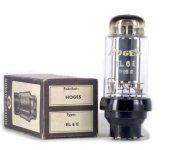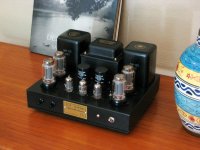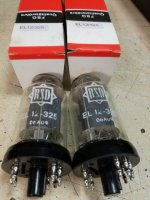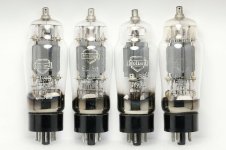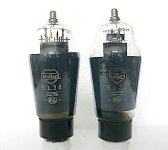Has anyone compared 2a3 tubes to 6B4G or 6C4C tubes in the same setup?
Not so easy since they have different sockets and filament voltages.
I'd like to know which are the best sounding devices. I know EH 2a3s sound better than Sovteks, and that the Sovtek 6C4C looks identical to the 2a3 version. But I haven't heard vintage 6B4G tubes. And also the usual 6C4C tubes are Svetlana and supposed to be modelled on the old RCA 2a3, so should be a step up from the Sovteks.
Any discussion here much appreciated. Looking to get a really good pair of one or the other for a build. Is there any mileage in building with 6B4Gs or should one stick to 2a3s?
Not so easy since they have different sockets and filament voltages.
I'd like to know which are the best sounding devices. I know EH 2a3s sound better than Sovteks, and that the Sovtek 6C4C looks identical to the 2a3 version. But I haven't heard vintage 6B4G tubes. And also the usual 6C4C tubes are Svetlana and supposed to be modelled on the old RCA 2a3, so should be a step up from the Sovteks.
Any discussion here much appreciated. Looking to get a really good pair of one or the other for a build. Is there any mileage in building with 6B4Gs or should one stick to 2a3s?
For all I know, 6B4G is supposed to be the identical to 2A3 except for the different sockets and filament voltages, and 6C4S is supposed to be a copy of 6B4G. I have some doubts regarding the last part after looking at the 6C4C curves, but they are drawn in a very different scale so it's not easy to compare.
I've recently paid good money for 8x 6C4C plus ~1200 euros for all the necessary iron so I sure hope the 6C4C is a good tube even if it's not an exact copy of 6B4G. They seemed very well behaved during some bench tests.
I've recently paid good money for 8x 6C4C plus ~1200 euros for all the necessary iron so I sure hope the 6C4C is a good tube even if it's not an exact copy of 6B4G. They seemed very well behaved during some bench tests.
Member
Joined 2009
Paid Member
In case it's helpful (not exactly on topic!) I have listened to the 6C4C and I wasn't wowed by what I heard. It was all Hammond iron and driver was a 6C45Pi through an IT transformer. In the same set up, with the 6C4C replaced by a 6P31S triode-wired, the 6P31S blew the 6C4C out of the water. Much smoother, fuller sound, from top to bottom. I had about a dozen NOS copies of 6C4C on-hand and after that experience I kept only two of them. I have not yet heard a 2A3 (hopefully will be finished this year). Of course, this is purely subjective.
6P31S is AFAIK the russian version of EL36. My latest project uses PL36 (the same thing buth with 25V heaters) in PP triode mode and it does indeed sound very, very good. The triode curves are guite similar to 2A3 curves but with slightly lower Rp and higher gm if I remember correctly. I have this idea to put a banana socket next to each output tube in my upcoming 6C4C PP amp to make it easily rewired for other tubes such as 6P31S, 6P21S, 6L6 and others. There are only a certain number of 6C4Cs left in the world...
Member
Joined 2009
Paid Member
I have a few of the tubes George praised but they are almost unavailable these days and their pin-out is different. The EL36 is a TV tube and there were plenty around when I looked a couple of years ago. The 6CM5 is also the same tube as the EL36, it's the Australian version.
Both 6AV5 and EL36/6P31S/6CM5 are TV sweep tubes, not identical but probably quite similar and quite nice as triodes. I have about a dozen Sylvania 6AV5GAs (not easy to find in Europe) and the only amp I have that uses them has a much too weak power supply to let the tubes sing at their full potential. NOS PL36 are on the other hand cheap and easy to find here and even though they are not exactly identical I would say that they do pretty much the same job as 6AV5.
Just to get back on topic: Anyone else than me who is under the impression that the 6C4C prefers higher Z plate loads than 2A3/6B4G?
Just to get back on topic: Anyone else than me who is under the impression that the 6C4C prefers higher Z plate loads than 2A3/6B4G?
I also have a bunch of 18GB5/LL500s that may be suitable for trioded operation in this application. I hear they also sound pretty nice when triode connected. However, the teensy plate caps are a PITA to deal with, as the available Chinese plate caps don't fit very well. I may have to resort to using repurposed fuse clips and silicone tubing per a previous post
Last edited:
Assuming 18GB5 is similar to 27GB5/PL504: Yes, also quite nice as triodes. Curves can be found in the PL504 datasheet. I remember running a pair as cathode followers at 260V 80mA into 3k pla...cathode loads, using choke loaded high-mu triodes as drivers. 3W or so per channel, but those three watts had a certain authority that you don't associate with small SE triode amps. They also work quite nicely into lower plate loads, I had some success with 1,5K OPTs with 25% CFB some twenty years ago.
Triode wired sweep tubes may lack audiophile status but they can definitely sound very good, especially when running a bit hot.
Triode wired sweep tubes may lack audiophile status but they can definitely sound very good, especially when running a bit hot.
Interesting diversion into EL36 types. I don't have any EL36 but I do have some fat bottle EL38s which are very fine tubes and IMO the best of the 6L6/EL34 types. Top cap unfortunately which I don't like since you have to make it safe somehow for children with prying fingers and careless adults. But the sound is there. 25W dissipation, so much more power available. And another good one without the top cap is the EL12n, at 18W dissipation so also a bit more volume. EL38 is mu=15 in triode and EL12n is mu=18 which gives more choice for the input stage. A 6SN7 would be perfectly fine, even a DHT with mu=8 ohms.
This is a timely reminded that for a bit more power I can use a good DHT input and an EL12n. I have a few and I know they sound good, not quite as good as a EL38 fat bottle but not far behind.
This is a timely reminded that for a bit more power I can use a good DHT input and an EL12n. I have a few and I know they sound good, not quite as good as a EL38 fat bottle but not far behind.
Which 2A3?
Vintage US-made Ken-Rad, RCA, Sylvania, National Union, etc? Or current production?
There were some cheap made in China 2A3s that New Sensor used to sell as 'Shuguang', but that was 30 years ago. They sounded good for me (push-pull 2A3 into Tango 45-watt OPTs) but they didn't last as long as some old Sylvania 5932/2A3W I had hoarded back in the 1980s.
I tried a few RCA, Tung-Sol, National Union branded 2A3s in that amp and the Chinese ones sounded very close to as good. They just didn't last as long, that's all.
I remember friends and I thought the Sovtek 6B4G sounded a little dull in comparison to the Chinese and NOS USA made 2A3s, but I don't remember more than that.
Triode-wired 6AV5GA will bias up very close to 6B4G with the same load, Ea, Ia, Rk, etc. I doubt they sound 'just like a 2A3,' but they might be pretty close. I would expect them to have that same 'falling grid curve' look on their plate curves getting towards cutoff, as opposed to the 2A3 and other DHTs staying more straight and parallel up toward cutoff. That would probably change the way they sound at higher power output. But will they sound drastically different at lower power? I don't know...
There are several other beam tetrode/sweep tubes that look a lot like 6AV5GA but have different basing, plate cap, etc. They're probably the same tube inside.
Vintage US-made Ken-Rad, RCA, Sylvania, National Union, etc? Or current production?
There were some cheap made in China 2A3s that New Sensor used to sell as 'Shuguang', but that was 30 years ago. They sounded good for me (push-pull 2A3 into Tango 45-watt OPTs) but they didn't last as long as some old Sylvania 5932/2A3W I had hoarded back in the 1980s.
I tried a few RCA, Tung-Sol, National Union branded 2A3s in that amp and the Chinese ones sounded very close to as good. They just didn't last as long, that's all.
I remember friends and I thought the Sovtek 6B4G sounded a little dull in comparison to the Chinese and NOS USA made 2A3s, but I don't remember more than that.
Triode-wired 6AV5GA will bias up very close to 6B4G with the same load, Ea, Ia, Rk, etc. I doubt they sound 'just like a 2A3,' but they might be pretty close. I would expect them to have that same 'falling grid curve' look on their plate curves getting towards cutoff, as opposed to the 2A3 and other DHTs staying more straight and parallel up toward cutoff. That would probably change the way they sound at higher power output. But will they sound drastically different at lower power? I don't know...
There are several other beam tetrode/sweep tubes that look a lot like 6AV5GA but have different basing, plate cap, etc. They're probably the same tube inside.
I had a pair of Sovtek 6B4G that I used in a SET years ago. I also remember it as a bit dull sounding, especially with wimpy driver tubes. The amp existed in several versions with different OPTs, drivers and power supplies. IIRC a Direct Reactance Drive version with E280F driver, 3k Lundahl OPTs (1663 or 1664, don't remember exactly) and over 300V plate to cathode on the power tubes sounded best. The first version with triode wired EF86 drivers and Hammond 1627 OPTs was the worst, I believe the 6B4G's Miller capacitance was way too high for the EF86.
- Home
- Amplifiers
- Tubes / Valves
- 2A3 versus 6B4G/6C4C
